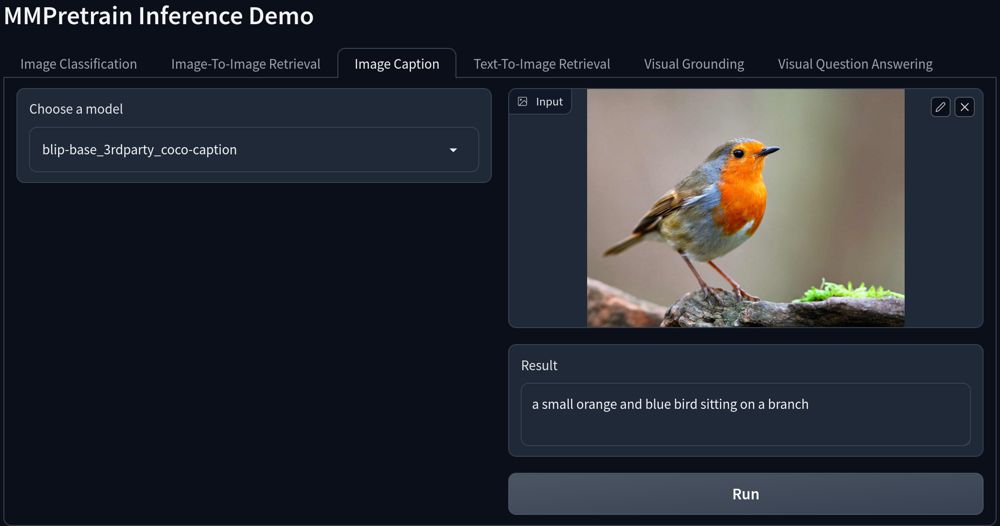Inference with existing models¶
This tutorial will show how to use the following APIs:
list_models: List available model names in MMPreTrain.get_model: Get a model from model name or model config.inference_model: Inference a model with the correspondding inferencer. It’s a shortcut for a quick start, and for advanced usage, please use the below inferencer directly.Inferencers:
ImageClassificationInferencer: Perform image classification on the given image.ImageRetrievalInferencer: Perform image-to-image retrieval from the given image on a given image set.ImageCaptionInferencer: Generate a caption on the given image.VisualQuestionAnsweringInferencer: Answer a question according to the given image.VisualGroundingInferencer: Locate an object from the description on the given image.TextToImageRetrievalInferencer: Perform text-to-image retrieval from the given description on a given image set.ImageToTextRetrievalInferencer: Perform image-to-text retrieval from the given image on a series of text.NLVRInferencer: Perform Natural Language for Visual Reasoning on a given image-pair and text.FeatureExtractor: Extract features from the image files by a vision backbone.
List available models¶
list all the models in MMPreTrain.
>>> from mmpretrain import list_models
>>> list_models()
['barlowtwins_resnet50_8xb256-coslr-300e_in1k',
'beit-base-p16_beit-in21k-pre_3rdparty_in1k',
...]
list_models supports Unix filename pattern matching, you can use ** * ** to match any character.
>>> from mmpretrain import list_models
>>> list_models("*convnext-b*21k")
['convnext-base_3rdparty_in21k',
'convnext-base_in21k-pre-3rdparty_in1k-384px',
'convnext-base_in21k-pre_3rdparty_in1k']
You can use the list_models method of inferencers to get the available models of the correspondding tasks.
>>> from mmpretrain import ImageCaptionInferencer
>>> ImageCaptionInferencer.list_models()
['blip-base_3rdparty_caption',
'blip2-opt2.7b_3rdparty-zeroshot_caption',
'flamingo_3rdparty-zeroshot_caption',
'ofa-base_3rdparty-finetuned_caption']
Get a model¶
you can use get_model get the model.
>>> from mmpretrain import get_model
# Get model without loading pre-trained weight.
>>> model = get_model("convnext-base_in21k-pre_3rdparty_in1k")
# Get model and load the default checkpoint.
>>> model = get_model("convnext-base_in21k-pre_3rdparty_in1k", pretrained=True)
# Get model and load the specified checkpoint.
>>> model = get_model("convnext-base_in21k-pre_3rdparty_in1k", pretrained="your_local_checkpoint_path")
# Get model with extra initialization arguments, for example, modify the num_classes in head.
>>> model = get_model("convnext-base_in21k-pre_3rdparty_in1k", head=dict(num_classes=10))
# Another example, remove the neck and head, and output from stage 1, 2, 3 in backbone
>>> model_headless = get_model("resnet18_8xb32_in1k", head=None, neck=None, backbone=dict(out_indices=(1, 2, 3)))
The obtained model is a usual PyTorch module.
>>> import torch
>>> from mmpretrain import get_model
>>> model = get_model('convnext-base_in21k-pre_3rdparty_in1k', pretrained=True)
>>> x = torch.rand((1, 3, 224, 224))
>>> y = model(x)
>>> print(type(y), y.shape)
<class 'torch.Tensor'> torch.Size([1, 1000])
Inference on given images¶
Here is an example to inference an image by the ResNet-50 pre-trained classification model.
>>> from mmpretrain import inference_model
>>> image = 'https://github.com/open-mmlab/mmpretrain/raw/main/demo/demo.JPEG'
>>> # If you have no graphical interface, please set `show=False`
>>> result = inference_model('resnet50_8xb32_in1k', image, show=True)
>>> print(result['pred_class'])
sea snake
The inference_model API is only for demo and cannot keep the model instance or inference on multiple
samples. You can use the inferencers for multiple calling.
>>> from mmpretrain import ImageClassificationInferencer
>>> image = 'https://github.com/open-mmlab/mmpretrain/raw/main/demo/demo.JPEG'
>>> inferencer = ImageClassificationInferencer('resnet50_8xb32_in1k')
>>> # Note that the inferencer output is a list of result even if the input is a single sample.
>>> result = inferencer('https://github.com/open-mmlab/mmpretrain/raw/main/demo/demo.JPEG')[0]
>>> print(result['pred_class'])
sea snake
>>>
>>> # You can also use is for multiple images.
>>> image_list = ['demo/demo.JPEG', 'demo/bird.JPEG'] * 16
>>> results = inferencer(image_list, batch_size=8)
>>> print(len(results))
32
>>> print(results[1]['pred_class'])
house finch, linnet, Carpodacus mexicanus
Usually, the result for every sample is a dictionary. For example, the image classification result is a dictionary containing pred_label, pred_score, pred_scores and pred_class as follows:
{
"pred_label": 65,
"pred_score": 0.6649366617202759,
"pred_class":"sea snake",
"pred_scores": array([..., 0.6649366617202759, ...], dtype=float32)
}
You can configure the inferencer by arguments, for example, use your own config file and checkpoint to inference images by CUDA.
>>> from mmpretrain import ImageClassificationInferencer
>>> image = 'https://github.com/open-mmlab/mmpretrain/raw/main/demo/demo.JPEG'
>>> config = 'configs/resnet/resnet50_8xb32_in1k.py'
>>> checkpoint = 'https://download.openmmlab.com/mmclassification/v0/resnet/resnet50_8xb32_in1k_20210831-ea4938fc.pth'
>>> inferencer = ImageClassificationInferencer(model=config, pretrained=checkpoint, device='cuda')
>>> result = inferencer(image)[0]
>>> print(result['pred_class'])
sea snake
Inference by a Gradio demo¶
We also provide a gradio demo for all supported tasks and you can find it in projects/gradio_demo/launch.py.
Please install gradio by pip install -U gradio at first.
Here is the interface preview:

Extract Features From Image¶
Compared with model.extract_feat, FeatureExtractor is used to extract features from the image files directly, instead of a batch of tensors.
In a word, the input of model.extract_feat is torch.Tensor, the input of FeatureExtractor is images.
>>> from mmpretrain import FeatureExtractor, get_model
>>> model = get_model('resnet50_8xb32_in1k', backbone=dict(out_indices=(0, 1, 2, 3)))
>>> extractor = FeatureExtractor(model)
>>> features = extractor('https://github.com/open-mmlab/mmpretrain/raw/main/demo/demo.JPEG')[0]
>>> features[0].shape, features[1].shape, features[2].shape, features[3].shape
(torch.Size([256]), torch.Size([512]), torch.Size([1024]), torch.Size([2048]))